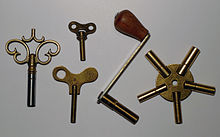Clockwork
This device functioned as a geared analogue computer after its creation during the first-century BCE timeframe, being somewhat astrolabe-like, and had been designed for calculating astronomical positions and particularly listing eclipses.
Recovered from a Greek shipwreck a long while after its creation, its nature was a mystery after its initial rediscovery due to various points of damage.
[5] At some point, this level of sophistication in clockwork technology was lost or forgotten in Europe, and only returned when brought from the Islamic world after the Crusades, along with other knowledge leading to the Renaissance.
For example, in Jewish legend, Solomon used his wisdom to design a throne with mechanical animals which hailed him as king when he ascended it; upon sitting down an eagle would place a crown upon his head, and a dove would bring him a Torah scroll.
And, indeed, it turned out to be only a construction of leather, wood, glue and lacquer, variously coloured white, black, red and blue.
Examining it closely, the king found all the internal organs complete—liver, gall, heart, lungs, spleen, kidneys, stomach and intestines; and over these again, muscles, bones and limbs with their joints, skin, teeth and hair, all of them artificial...The king tried the effect of taking away the heart, and found that the mouth could no longer speak; he took away the liver and the eyes could no longer see; he took away the kidneys and the legs lost their power of locomotion.
The clocks did not keep time very accurately by modern standards, but the astronomical devices were carefully used to predict the positions of planets and other movement.
The monk is driven by a key-wound spring and walks the path of a square, striking his chest with his right arm, while raising and lowering a small wooden cross and rosary in his left hand, turning and nodding his head, rolling his eyes, and mouthing silent obsequies.


